PAID ENDORSEMENT DISCLOSURE: In order for me to support my blogging activities, I may receive monetary compensation or other types of remuneration for my endorsement, recommendation, testimonial and/or link to any products or services from this blog. However, I only recommend products or services I have personally used myself and trust.
Yogi Mami/Victoria Moore is a participant in the Amazon Services LLC Associates Program, an affiliate advertising program designed to provide a means for sites to earn advertising fees by advertising and linking to Amazon.com.
There is no denying the miraculous life experience of pregnancy and childbirth, however, there can be quite a bit of discomfort and anxiety involved for the expecting mother. In fact, it is one of the most physically demanding events of a woman’s life. There are many uncontrollable factors such as the size and positioning of the baby, the intensity of the contractions, and the amount of space in the pelvic girdle. Pregnancy brings along with it many symptoms such as headaches, morning sickness, joint pain and insomnia. While these elements can be out of the woman’s control there is a way that the mother-to-be can prepare to have an enjoyable pregnancy and manageable labor. Prenatal yoga offers expectant mothers spiritual, mental and physical comfort during both pregnancy and labor, which is beneficial on this life-changing journey. This article will discuss how prenatal yoga can be incorporated into a daily regimen to achieve a happy and healthy pregnancy and childbirth.
About Prenatal Yoga:
Practicing yoga everyday is preferred, but if not, at least 3 times a week to receive the most benefits. It is important to find the right practice whether it’s at a studio, gym, DVD or your personal home practice. Prenatal yoga helps to stretch the growing body, quiet the mind and help prepare for the demands of motherhood. Breathing and postures increase lung capacity, improve quality of sleep and help you to connect with your baby more deeply. While you many not want to work out during the first trimester due to morning sickness or being tired, practicing prenatal yoga can bring relief to many of the impinging symptoms that occur throughout the pregnancy. Modification of poses can be used throughout the pregnancy to adapt to the growing body.
Benefits of Prenatal Yoga During Labor:
Prenatal yoga helps to promote body awareness by teaching the individual how to go within and listen to the needs of the body. Yoga focuses on breathing (pranayama), postures (asanas) and meditation as a way to distinguish areas where tension is being held. Awareness of these areas allows the woman to release that tightness, letting the body open up and facilitate labor. When the body is stiff and rigid, it prevents labor from progressing smoothly. In addition, the deep connection with the body allows the women to rely less on medical thinking and more on the intuitive wisdom of the human body. Prenatal yoga during pregnancy offers countless benefits when it comes to relieving pregnancy discomforts and managing pain during childbirth.
Prenatal Yoga Postures To Alleviate Common Pregnancy Symptoms:
Balasana/Child’s Pose: Kneel on the floor, (use blankets as needed to support knees) touching your big toes and sitting back on your heels. Open your knees hip distance, or wider. Inhale through the nose bringing your arms over head, and during the exhale lower your torso down in between your knees and rest your forehead on the mat. Your arms are overhead resting on the floor. You also have the option to rest the head on a block, bolster or pillow for added support. Rest in this position as long as is comfortable. This pose is great for relieving headaches, morning sickness or heartburn simply by placing a bolster under the head and chest for extra support. It helps to prevent and relieve hemorrhoids and is great for preparing for a restful night sleep.
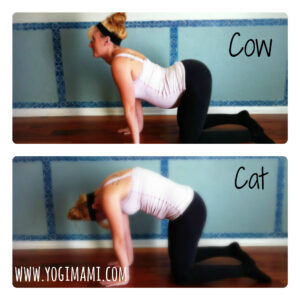 Cat/Cow: Start on your hands and knees in tabletop pose with your knees under your hips and your wrist, elbows and shoulders all in one line with head in a neutral position. Inhale, gazing up towards the sky and raising your sit bones toward the sky and letting your belly drop towards the floor. This is a great position in the 3rd trimester as it creates a lot of space in the womb to give some relieve to mama and baby. On the exhale press your palms into the mat, tuck your neck and pelvis and round your back just like an angry cat. Flow through these two postures for 10-20 breathes each. This combination is great for stretching out the spine, releasing back tension and helping the baby to move off the sciatic nerve. Practicing this posture daily helps to move and keep the baby in an optimal birthing position.
Cat/Cow: Start on your hands and knees in tabletop pose with your knees under your hips and your wrist, elbows and shoulders all in one line with head in a neutral position. Inhale, gazing up towards the sky and raising your sit bones toward the sky and letting your belly drop towards the floor. This is a great position in the 3rd trimester as it creates a lot of space in the womb to give some relieve to mama and baby. On the exhale press your palms into the mat, tuck your neck and pelvis and round your back just like an angry cat. Flow through these two postures for 10-20 breathes each. This combination is great for stretching out the spine, releasing back tension and helping the baby to move off the sciatic nerve. Practicing this posture daily helps to move and keep the baby in an optimal birthing position.
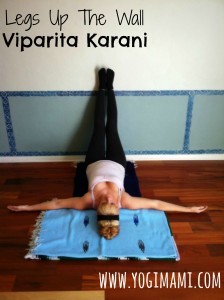 Viparita Karani/Legs up the wall: This posture might take a little more effort, especially towards the end of your pregnancy, but I promise you it’s worth it! Find a spot near a wall and have a couple of folded blankets or a bolster/pillow to place under your hips. Lay on your back and swing your legs up onto the wall. You do not need to have your bottom all the way up against the wall. You can be at an angle. The important part is that your legs are elevated. This posture is useful for preventing and relieving hemorrhoids, swelling of the legs and feet and varicose veins. Practicing this posture before bed is helpful to promote restful sleep.
Viparita Karani/Legs up the wall: This posture might take a little more effort, especially towards the end of your pregnancy, but I promise you it’s worth it! Find a spot near a wall and have a couple of folded blankets or a bolster/pillow to place under your hips. Lay on your back and swing your legs up onto the wall. You do not need to have your bottom all the way up against the wall. You can be at an angle. The important part is that your legs are elevated. This posture is useful for preventing and relieving hemorrhoids, swelling of the legs and feet and varicose veins. Practicing this posture before bed is helpful to promote restful sleep.
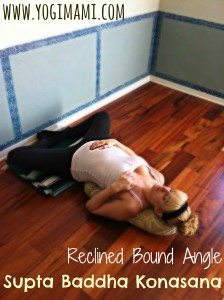 Supta Baddha Konasana/Reclined Bound Angle: Lay a bolster, or folded blanket in the middle of the mat. sit down at the end of the blanket and bring your feet to touch with your knees opening out to the side. Slowly lay back onto the bolster, or blanket making sure your head and neck is supported. Allow the pelvic region to sink into the mat, which will allow the hips to open up even more. It is beneficial to use a wall to hold your feet into place otherwise as you tend to settle into the posture your legs will begin to slide away from your body. You can also use a strap to hold the feet into place. This nurturing and restorative posture helps to relieve heartburn and morning sickness, as well as opening up the chest and relieving back tension. This posture can be held as long as is comfortable and even be used during meditation, or visualization sessions.
Supta Baddha Konasana/Reclined Bound Angle: Lay a bolster, or folded blanket in the middle of the mat. sit down at the end of the blanket and bring your feet to touch with your knees opening out to the side. Slowly lay back onto the bolster, or blanket making sure your head and neck is supported. Allow the pelvic region to sink into the mat, which will allow the hips to open up even more. It is beneficial to use a wall to hold your feet into place otherwise as you tend to settle into the posture your legs will begin to slide away from your body. You can also use a strap to hold the feet into place. This nurturing and restorative posture helps to relieve heartburn and morning sickness, as well as opening up the chest and relieving back tension. This posture can be held as long as is comfortable and even be used during meditation, or visualization sessions.
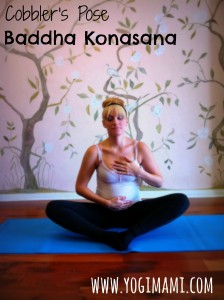
Baddha Konasana/Cobblers Pose: Sit with your legs extended out in front of you. You can sit on a block, or blankets if you have tight hips. Bend your knees, bringing the soles of the feet to touch and allowing your knees to drop out to the sides. Back is straight and you can rest your hands on your knees or you can bring your hands to prayer center. This posture is great for relieving sciatica and back pain. It stimulates the digestive system and relaxes the pelvic region. This posture should be practiced daily, especially for pregnant women who sit for long periods of time.
Breathing Exercises:
Breathing techniques are important to practice during pregnancy to help the body become familiar with conscious breathing when it is time for labor. During moments of stress our breathing typically becomes rapid and shallow resulting in less oxygen circulating through the body. In labor, breathing techniques calm the mind, bring fresh oxygenated blood to body/baby and provide energy. Taking the time to discipline the mind and body to breathe more efficiently is helpful in all aspects of life and improves overall well-being.
Deep Yogic breathing is deep, even inhalations through the nose and deep even exhalations through the nose. Deep breathing involves complete expansion and contraction of your lungs. This breath is used to replenish healing qualities that are needed to maintain harmony and balance. Being conscious to completely fill and empty the lungs while also paying attention to your facial muscles, making sure the muscles around the eyes and the jaw are relaxed. We carry stress in our face, hips and shoulders, so consciously relaxing one area tends to spread relaxation to those areas as well.
Cleansing breath follows the same principal as deep yogic breathing, but has a strong emphasis on the exhalation through the mouth instead of the nose. This breath is used to clear away tension, discomfort and negative thoughts and emotions. Bring your attention to those tense or negative feelings and imagine they are being blown away with each breath as you exhale forcefully through the mouth. Cleansing breathe helps to clear carbon dioxide from your lungs and encourages the body to relax.
Meditation Techniques:
Relaxation and visualization play important roles during pregnancy and labor. Practicing these techniques regularly work to condition the mind and is a great way to eliminate any fears and anxiety associated with the birth process. Taking the time daily to relax and mediate helps to eliminate muscle tension and making the relaxation response easier to reach during childbirth. Bonding exercises are a great way to connect with your little one while in the womb and begin the parenting relationship. Envisioning a successful labor can bring confidence in the woman’s ability to birth without the need for medical interventions. Many of the restorative postures can be held for long periods of time and are ideal to pair with relaxation and meditation. Affirmations and mudras (hand postures) are also useful during these exercises as a way for the expecting mother to tune in with her body and her baby and trust in their ability to have a fulfilling labor experience.
You can learn more about how to have an easier pregnancy and labor in my ebook available on Amazon. Click here to get your copy!
Did you use yoga during your pregnancy? If so, how did it help you and what was your favorite pose?
Like what you've read? Sign-up for my newsletter and get tips and other information on how to live a healthier and happier lifestyle!
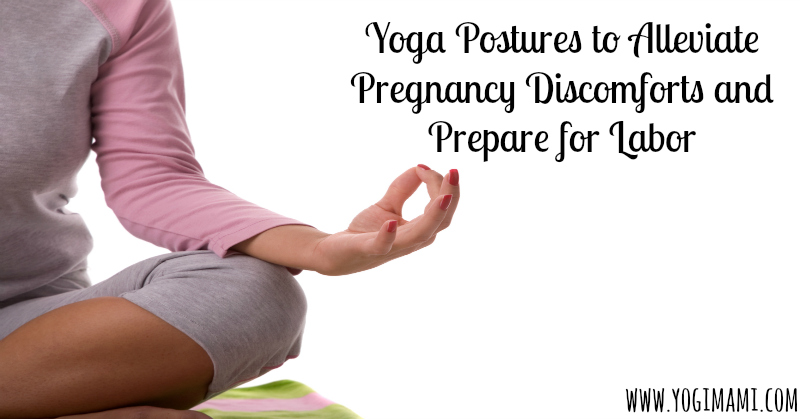
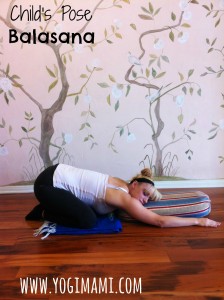
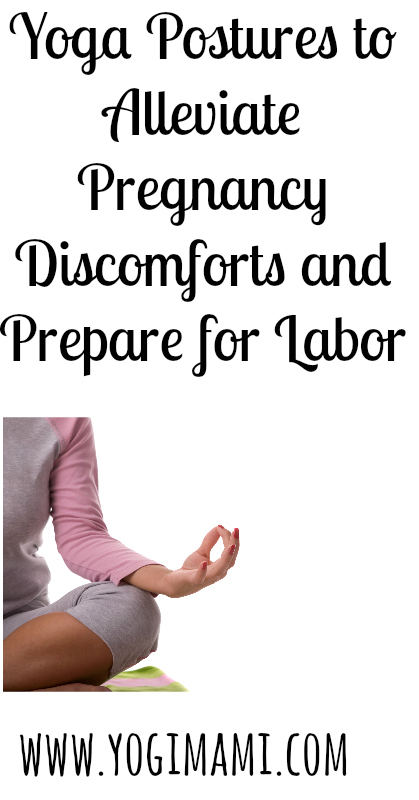

Great information. Lucky me I discovered your blog by accident (stumbleupon).
I’ve bookmarked it for later!